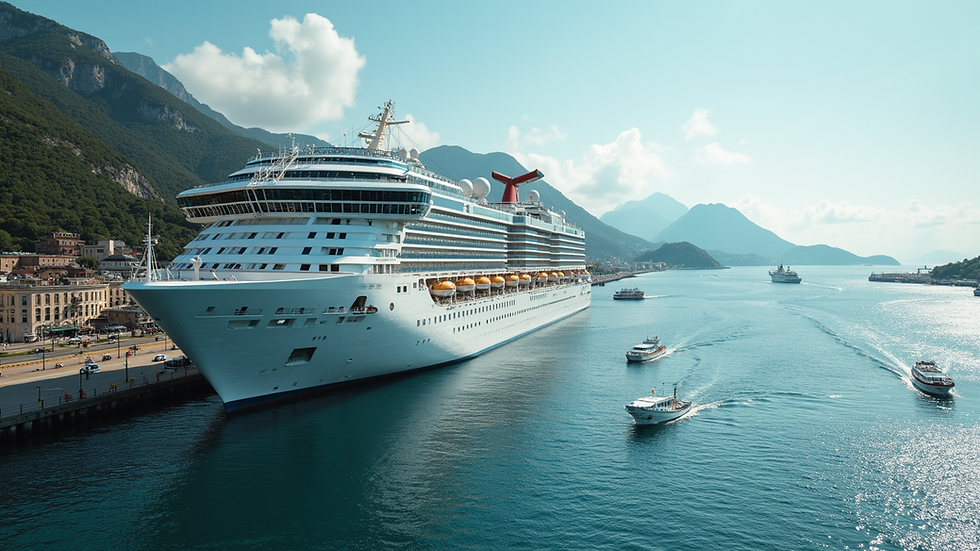The Role of Innovation in Greener Maritime Solutions
- Elizaa Liza
- May 19
- 4 min read
The maritime industry plays a crucial role in global trade and economy, but it also significantly contributes to environmental challenges. With rising awareness about climate change and sustainability, the sector must innovate to minimize its ecological footprint. In this blog post, we will explore the role of innovation in creating greener maritime solutions, focusing on technological advancements, alternative fuels, and sustainable practices.
Maritime Innovation
The concept of maritime innovation encompasses various technological advancements and methodologies aimed at improving efficiency while reducing environmental impact. For instance, the adoption of advanced hull designs, energy-efficient engines, and automated systems can lead to decreased fuel consumption and lower emissions.
One notable example is the use of data analytics and the Internet of Things (IoT) in shipping fleets. Companies like Maersk are utilizing real-time data to optimize routes and reduce unnecessary fuel usage. Such innovations not only cut costs but also contribute towards environmental sustainability.

Another significant area of maritime innovation is the development of autonomous vessels. These ships use artificial intelligence to navigate and transport goods without human intervention. Autonomous shipping has the potential to enhance safety and efficiency while minimizing the risks of human error.
Innovative Technologies Driving Change
Several innovative technologies are rapidly emerging to support greener maritime solutions. Here are a few key advancements:
1. Renewable Energy Solutions
Wind and solar energy are becoming increasingly popular in maritime applications. Vessels equipped with wind-assisted propulsion or solar panels can reduce reliance on fossil fuels. For instance, the "Maersk Pelican," a vessel using rotor sails, reportedly has achieved fuel savings of up to 10%.

2. Alternative Fuels
The maritime industry is exploring alternative fuels such as liquefied natural gas (LNG), hydrogen, and biofuels. LNG is cleaner than traditional marine fuels, emitting lower levels of sulfur oxides and nitrogen oxides. For example, the "AIDAnova," a cruise ship powered entirely by LNG, represents a significant step towards greener cruising.
Hydrogen fuel cells offer another promising alternative. Various companies are currently testing hydrogen-powered vessels. The M/S Energy Observer, a research vessel, operates using hydrogen produced from renewable energy sources, demonstrating the viability of such technologies.
3. Waste Management Innovations
Innovative waste management practices are crucial for minimizing waste in the maritime industry. Advanced treatment systems on ships help process waste effectively, ensuring that only clean water is discharged into oceans. For instance, the use of anaerobic digestion systems can convert organic waste into biogas, which can be used for energy.
What is the meaning of marine sustainability?
Marine sustainability emphasizes the need to preserve ocean ecosystems, ensuring they can continue to provide essential resources and services. This concept encompasses practices that reduce overfishing, pollution, and habitat destruction.
To achieve marine sustainability, the maritime industry must integrate conservation efforts into its operations. This includes monitoring marine biodiversity and adopting practices that protect vulnerable species and habitats.
The Importance of Collaboration
Collaboration among various stakeholders plays a vital role in promoting innovation in the maritime industry. Governments, businesses, and research institutions must work together to develop and implement cutting-edge technologies. For example, initiatives like the Global Industry Alliance for Marine Biosafety invite partners to share best practices and solutions.
Collaboration can also facilitate funding for green initiatives. The International Maritime Organization (IMO) recognizes the importance of investment in sustainable technologies, urging countries to support research and development in this sector.
Real-World Examples of Green Innovation
Several companies are leading the charge in maritime innovation towards greener solutions. Here are a few noteworthy examples:
1. Stena Line
Stena Line, a prominent ferry operator, has committed to a 50% reduction in greenhouse gas emissions by 2030. The company is investing in hybrid ferries that combine battery power with traditional engines. Their newest vessel, "Stena Elektra," aims to operate almost completely on electricity.
2. Wärtsilä
Wärtsilä is a technology company focusing on making marine vessels more efficient. They've developed an "EnergoProFin," a device that improves a vessel's propulsion efficiency and reduces fuel consumption. This technology is expected to significantly cut greenhouse gas emissions from various ships.
3. Port Innovations
Ports are critical to reducing the maritime industry's environmental impact. Many ports are embracing innovations such as cold ironing, where vessels plug into shore power instead of using auxiliary engines. This transition can drastically lower emissions while ships are docked.
The Future of Sustainable Maritime Development
The future of the maritime industry lies in committing to sustainable practices and fostering innovation. With growing technology advancements, the possibilities for greener maritime solutions are expanding. The combination of alternative fuels, eco-friendly designs, and efficient practices can significantly reduce the industry’s environmental impact.
Moreover, the shift towards sustainable maritime development requires policies that promote innovation and support investments in greener technologies. As stakeholders embrace these changes, the maritime industry can play a significant role in combating climate change.
Governments and regulatory bodies also have a responsibility to create frameworks that incentivize green investments and facilitate research into sustainable solutions. Evolving regulations must include stringent emissions standards, encouraging both shipbuilders and operators to adopt greener technologies.
Preliminary Actions for Maritime Companies
To thrive in a future driven by sustainability, maritime companies should consider the following starter actions:
Invest in Research: Allocate funds for research into sustainable technologies and practices.
Adopt Cleaner Fuels: Transition to cleaner fuel options such as LNG or biofuels to reduce emissions.
Embrace Automation: Invest in automated and remotely operated vessels to enhance efficiency.
Train Employees: Ensure staff are knowledgeable about sustainable practices and the importance of innovation in the maritime sector.
Collaborate: Form partnerships within the industry and with research institutions to share best practices and solutions.
By taking these steps, maritime companies can significantly contribute to a greener future while remaining competitive in an increasingly sustainability-focused market.

The role of innovation in creating greener maritime solutions is undeniable. As the industry evolves, embracing innovation will be crucial for a sustainable future. Through collaboration, investment, and a commitment to greener practices, the maritime sector can lead the way in achieving a substantial reduction in its environmental impact.


Comments